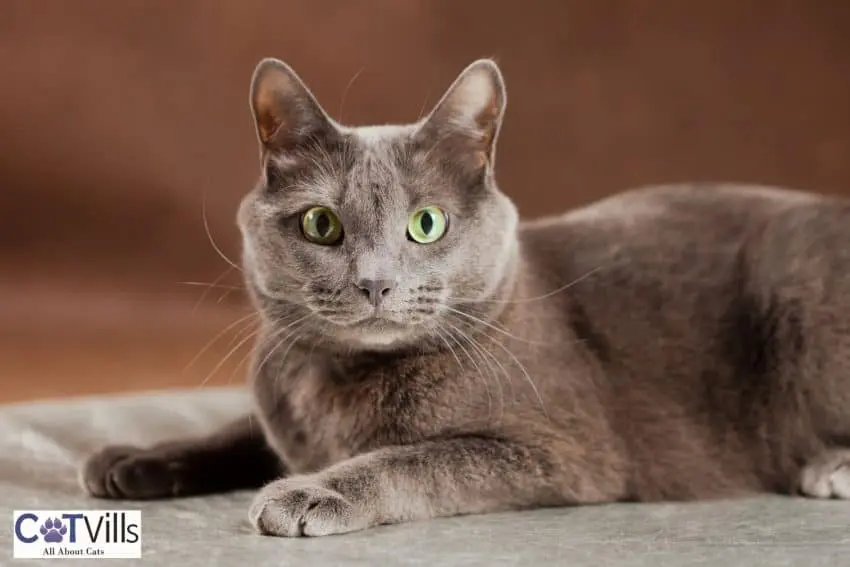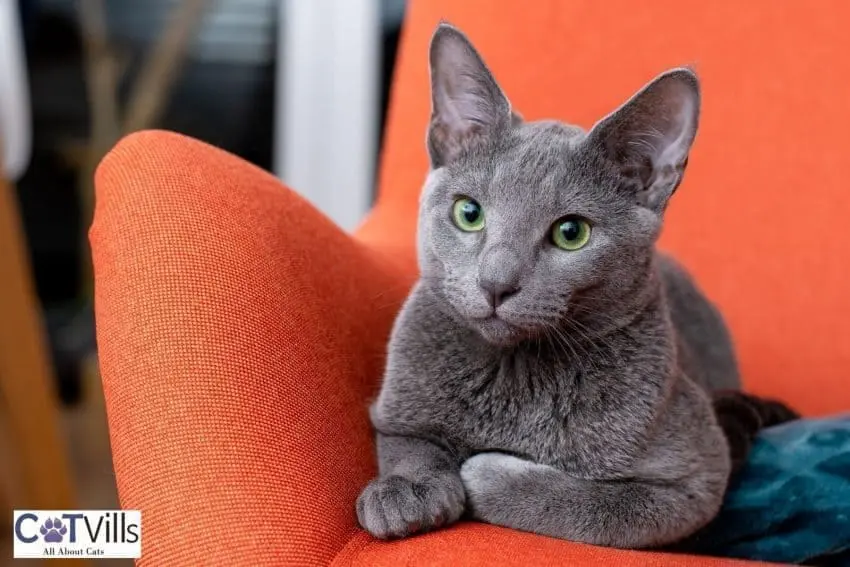Last Updated: 4 months ago
Are Russian blue cats hypoallergenic? This is a question that I often encounter when talking to cat lovers who are allergic to animal fur.
Is there anything like a hypoallergenic Russian blue cat? What tips and considerations should be considered when choosing one for an allergy-prone family member?
Read more to find out.
What are Russian Blue Cats?

Russian blues are cat breeds of medium size with a blue-gray, thick, double coat that does not shed much. This gives it a blue-coat look.
Their coats may be colored anywhere from light silver to a deep slate.
They are believed to have originated from Northern Russia and fall under the same classification as the British Blue Cat, the French Chartreux, and the Thai Korat.
Russian blue cats are known by their other names: Archangel Blues, Foreign Blues, and Maltese Cats.
Along with the Devon Rex, Sphinx, and other hypoallergenic breeds of cats, they are the perfect breed for people with allergies.
Many studies have argued against using the term “hypoallergenic” in animals.
To understand hypoallergenicity, it would be best to first understand why cats cause allergies in the first place.
Are Russian Blue Cats Hypoallergenic?

There is no such thing as a hypoallergenic cat.
That said, there are ways and means to lessen your allergic reaction so you can still enjoy time with your furry friend.
But first, let’s understand what can cause an allergic reaction in a cat or kitty. To answer this question, we first have to look into a protein known as Fel D1.
Understand Fel D1: The Main Cat Allergy Culprit
Ten allergenic proteins have been identified as sources of cat allergies.
Of these ten, the major allergen is Fel D1 (2) protein, which is airborne. This glycoprotein is found in every cat’s saliva, anal glands, sebaceous glands, skin, and fur.
The Russian blue cat is not exempt from this.
The function of this protein is still unknown, although it is believed to help protect the skin and mucosa of cats. It is considered the biggest culprit for those who have allergies to cats.
Among all the allergens, this has the most clinical significance. It can lead to anything from mild allergies to more severe problems, such as severe asthma, that are life-threatening.
Thus, to avoid all of these reactions, the focus has to be put not on the cat’s fur alone but rather on the levels of Fel D1.
Lessen the Levels of Fel D 1 in Cats To lessen Your Allergic reaction
Even though Russian Blue cats are not hypoallergenic, there are ways by which you can lessen the level of Fel D 1 in cats, including the Russian Blues.
Studies have shown that modifying your Russian Blue’s diet may lessen levels of Fel D1 in your cat.
A study concluded in 2018 has shown that supplementing a cat’s diet with an anti-Fel D1 IgY antibody from chicken eggs greatly reduces the amount of Fel D1 in a cat’s skin.
This is because the anti-Fel D 1 antibody can bind (or “pair”) with Fel D1, thus keeping it busy in the cat’s blood. This inactivates Fel D1 in the cat’s hair, even in high concentrations.
As mentioned, Fel D1 is found in all cats, regardless of breed.
Russian blues are no exception. However, they may not cause as many allergic reactions in some people.
Since they are short-haired, they lessen the chances of shedding as much hair and Fel D1 in their surroundings.
Russian Blue Cats Don’t Shed Much

Compared to other cats, Russian blues don’t shed so much. This also means that they do not produce dander, leading to allergies.
Irritating allergens trigger allergies in humans. Even the smallest amount can nevertheless cause allergic reactions.
The short hair of Russian blues, as well as a lessened tendency to shed, decreases the chances of you getting allergies from them.
Bear in mind, though, that they still have the protein Fel D 1 in them, so it can still trigger your allergies.
What to Do About Your Allergies to Cats
So you want to own a Russian blue (and who can blame you?) but are worried about allergies.
The sinister news is that you really can’t do much about cats’ leading cause of allergies.
Fel D1 is a protein found in cats, and you cannot do much about this.
The good news, though, is that research is underway. Treatments are being developed to address this situation.
Hypoallergenic Fel D 1
There have been attempts to change the molecular structure of Fel D1 to make it easier to use for AIT. This may lead to the development of future vaccines that will lessen your body’s reaction to Fel D1.
Studies in rabbits have already shown success rates. Hopefully, this will result in the same effect on humans in the future!
Allervax CAT and CAT PAD
These vaccines are currently under clinical trials, which have shown promising results.
Allervax CAT has shown a reduction in allergic reactions in individuals after six weeks.
CAT PAD has shown similar results, lasting for up to two years.
These are all currently undergoing clinical trials and, indeed, are something to look forward to in the future.
In the meantime, other steps can be taken to address your concerns regarding your allergies to Russian blue cats.
Steps to Prevent Allergies To Cats

If you are determined to have or keep your Russian blue cat, these are some forms of treatment that you may consider to lessen the symptoms you may feel whenever your cat is around.
- Allergen-Specific Immunotherapy: This involves exposing you to the allergen Fel D1 in microdoses, so your system slowly gets used to the pesky allergen.
- Antihistamines: There are over-the-counter (OTC) allergy pills like loratadine (Claritin) and cetirizine (Zyrtec) that you can take whenever your allergies get too hard to handle
- Nasal sprays: Corticosteroid nasal sprays like fluticasone (Flonase) or mometasone (Nasonex) can significantly alleviate symptoms like a clogged nose or rhinitis.
- Leukotriene inhibitors: Medication like montelukast (Singulair) can be prescribed by your doctor and taken as maintenance to help reduce allergic reactions.
- Nasal lavage: This is a home remedy that you can try to ease allergy symptoms if you aren’t willing to consume any medication.
- Air purifiers: Since Fel D 1 is airborne, air purifiers with HEPA filters can significantly help reduce the amount of Fel D 1 and dander in the air that is the primary cause of your allergies.
FAQs

Is there such a thing as a hypoallergenic cat?
No. All cats contain a protein called Fel D 1, which can cause allergic reactions in sensitive individuals.
Can antihistamines be taken to lessen allergy symptoms in cats?
Yes. Many medications can be used to lessen symptoms, such as antihistamines and nasal sprays. You can try nasal lavages to help alleviate allergic reactions to cats.
Conclusion
Russian blue cats are fun pets to own. Unfortunately, many may have a problem tolerating cats as pets due to allergies that they may have to cats.
Russian blues are not exceptions, despite claims that they are hypoallergenic since there is no such thing as hypoallergenic cat breeds.
Try to weigh things and see if you will sustain these forms of management if you are allergic to cats, so you can be assured of a happy, long-term relationship with your feline friend.
References:


Dr. Linda Simon MVB MRCVS is a locum veterinary surgeon who has worked in London for the past 8 years. She graduated top of her class in small animal medicine from UCD, Dublin. She is currently a member of the Royal College of Veterinary Surgeons. Linda is the resident vet for Woman magazine and a frequent contributor to People’s Friend Magazine, the Dogzone website, Vet Help Direct and Wag! Linda also writes content for the CVS veterinary group, Vetwriter and a number of other establishments.

🙋🏼 thank you that was so interesting article and wonderful information. I am sometimes allergic to some cats and then there are some I am not allergic to. I’ve been debating on adopting a main coon kitten. I want to make sure that’s the right pet for me before I purchase not only because they are expensive but it’s heartbreaking to have to rehome. Thanks Carmen.